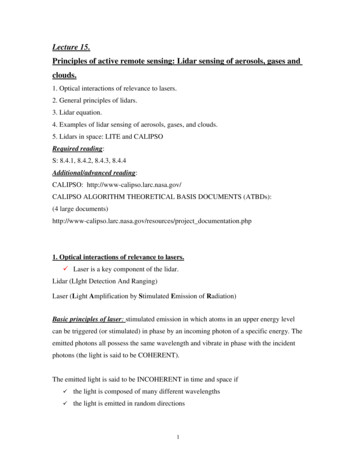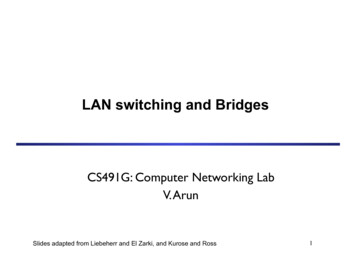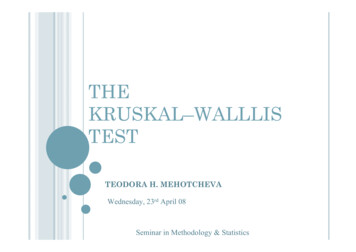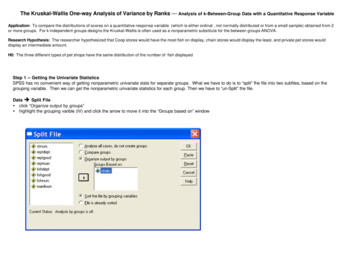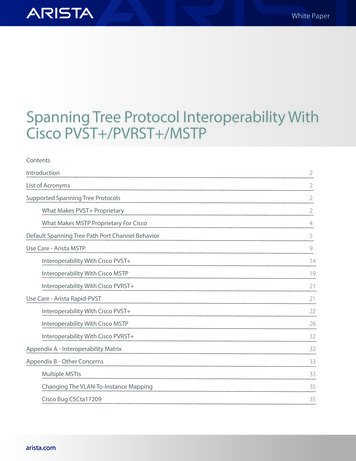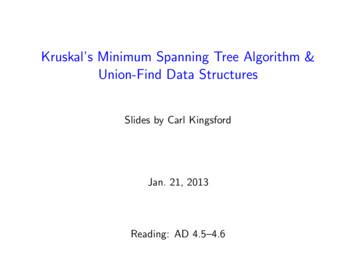
Transcription
Kruskal’s Minimum Spanning Tree Algorithm &Union-Find Data StructuresSlides by Carl KingsfordJan. 21, 2013Reading: AD 4.5–4.6
Greedy minimum spanning tree rulesAll of these greedy rules work:1. Starting with any root node, add the frontier edge with thesmallest weight. (Prim’s Algorithm)2. Add edges in increasing weight, skipping those whose additionwould create a cycle. (Kruskal’s Algorithm)3. Start with all edges, remove them in decreasing order ofweight, skipping those whose removal would disconnect thegraph. (“Reverse-Delete” Algorithm)
Prim’s AlgorithmPrim’s Algorithm: Starting with any root node, add the frontieredge with the smallest weight.Theorem. Prim’s algorithm produces a minimum spanning tree.veruS set of nodes already inthe tree when e is added
Cycle PropertyTheorem (Cycle Property). Let C be a cycle in G . Lete (u, v ) be the edge with maximum weight on C . Then e is notin any MST of G .Suppose the theorem is false. Let T be a MST that contains e.Deleting e from T partitions vertices into 2 sets:S (that contains u) and V S (that contains v ).Cycle C must have some other edge f that goes from S and V S.Replacing e by f produces a lower cost tree, contradicting that Tis an MST.
Cycle Property, PictureVfeuSvV-S
MST Property Summary1. Cut Property: The smallest edge crossing any cut must be inall MSTs.2. Cycle Property: The largest edge on any cycle is never in anyMST.
Reverse-Delete AlgorithmReverse-Delete Algorithm: Remove edges in decreasing order ofweight, skipping those whose removal would disconnect the graph.Theorem. Reverse-Delete algorithm produces a minimumspanning tree.Because removing e won't disconnect the graph,there must be another path between u and vve (u,v)uBecause we're removing in order of decreasing weight,e must be the largest edge on that cycle.
Kruskal’s AlgorithmKruskal’s Algorithm: Add edges in increasing weight, skippingthose whose addition would create a cycle.Theorem. Kruskal’s algorithm produces a minimum spanning tree.Proof. Consider the point when edge e (u, v ) is added:vS nodes to which v has a pathjust before e is addede (u,v)uu is in V-S(otherwise therewould be a cycle)
Example run of Kruskal’s1748141019169182135 12031111567
Example run of Kruskal’s1748141019169182135 12031111567
Example run of Kruskal’s1748141019169182135 12031111567
Example run of Kruskal’s1748141019169182135 12031111567
Example run of Kruskal’s1748141019169182135 12031111567
Example run of Kruskal’s1748141019169182135 12031111567
Example run of Kruskal’s1748141019169182135 12031111567
Example run of Kruskal’s1748141019169182135 12031111567
Example run of Kruskal’s1748141019169182135 12031111567
Example run of Kruskal’s1748141019169182135 12031111567
Example run of Kruskal’s1748141019169182135 12031111567
Example run of Kruskal’s1748141019169182135 12031111567
Example run of Kruskal’s1748141019169182135 12031111567
Example run of Kruskal’s1748141019169182135 12031111567
Example run of Kruskal’s1748141019169182135 12031111567
Example run of Kruskal’s1748141019169182135 12031111567
Example run of Kruskal’s1748141019169182135 12031111567
Example run of Kruskal’s1748141019169182135 12031111567
Example run of Kruskal’s1748141019169182135 12031111567
Another 12815101315101612111117935814935806971811941612
Data Structure for Kruskal’s AlgorithmKruskal’s Algorithm: Add edges in increasing weight, skippingthose whose addition would create a cycle.How would we check if adding an edge {u, v } would create a cycle?
Data Structure for Kruskal’s AlgorithmKruskal’s Algorithm: Add edges in increasing weight, skippingthose whose addition would create a cycle.How would we check if adding an edge {u, v } would create a cycle?IWould create a cycle if u and v are already in the samecomponent.
Data Structure for Kruskal’s AlgorithmKruskal’s Algorithm: Add edges in increasing weight, skippingthose whose addition would create a cycle.How would we check if adding an edge {u, v } would create a cycle?IWould create a cycle if u and v are already in the samecomponent.IWe start with a component for each node.
Data Structure for Kruskal’s AlgorithmKruskal’s Algorithm: Add edges in increasing weight, skippingthose whose addition would create a cycle.How would we check if adding an edge {u, v } would create a cycle?IWould create a cycle if u and v are already in the samecomponent.IWe start with a component for each node.IComponents merge when we add an edge.
Data Structure for Kruskal’s AlgorithmKruskal’s Algorithm: Add edges in increasing weight, skippingthose whose addition would create a cycle.How would we check if adding an edge {u, v } would create a cycle?IWould create a cycle if u and v are already in the samecomponent.IWe start with a component for each node.IComponents merge when we add an edge.INeed a way to: check if u and v are in same component andto merge two components into one.
Union-Find Abstract Data TypeThe Union-Find abstract data type supports the followingoperations:IUF.create(S) — create the data structure containing S sets,each containing one item from S.IUF.find(i) — return the “name” of the set containing item i.IUF.union(a,b) — merge the sets with names a and b into asingle set.
A Union-Find Data StructureUF Items:UF 5UF Sets Array:1214267112471447171234567891011121314151617
Implementing the union & find operationsmake union find(S) Create data structures on previous slide.Takes time proportional to the size of S.find(i) Return UF.sets[i].Takes a constant amount of time.union(x,y) Use the “size” array to decide which set is smaller.Assume x is smaller.Walk down elements i in set x, setting sets[i] y.Set size[y] size[y] size[x].
Runtime of array-based Union-FindTheorem. Any sequence of k union operations on a collection of nitems takes time at most proportional to k log k.Proof. After k unions, at most 2k items have been involved in aunion. (Each union can touch at most 2 new items).We upper bound the number of times set[v ] changes for any v :IEvery time set[v ] changes, the size of the set that v is in atleast doubles. why?ISo, set[v ] can have changed at most log2 (2k) times.At most 2k items have been modified at all, and each updated atmost log2 (2k) times 2k log2 (2k) work.
Running time of Kruskal’s algorithmSorting the edges: m log m for m edges.m n2 , so log m log n2 2 log nTherefore sorting takes m log n time.At most 2m “find” operations: 2m time.At most n 1 union operations: n log n time. Total running time of m log n 2m n log n.The biggest term is m log n since m n if the graph is connected.
Another way to implement Union-Find13281065712172105161395
Another way to implement Union-Find132810union(1,2)13965712172105165
Tree-based Union-Findmake union find(S) Create S trees each containing a single itemand size 1. Takes time proportional to the size of S.find(i) Follow the pointer from i to the root of its tree.union(x,y) If the size of set x is that of y , make y point to x.Takes constant time.
Runtime of tree-based FindTheorem. find(i) takes time log n in a tree-based union-finddata structure containing n items.Proof. The depth of an item equals the number of times the set itwas in was renamed.The size of the set containing v at least doubles every time thename of the set containing v is changed.The largest number of times the size can double is log2 n.
Running time of Kruskal’s algorithm usingtree-based union-findSame running time as using the array-based union-find:ISorting the edges: m log n for m edges.IAt most 2m “find” operations: log n time each.IAt most n 1 union operations: n time. Total running time of m log n 2m log n n.The biggest term is m log n since m n if the graph is connected.
e (u;v) be the edge with maximum weight on C. Then e isnot in any MST of G. Suppose the theorem is false. Let T be a MST that contains e. Deleting e from T partitions vertices into 2 sets: S (that contains u) and V S (that contains v

